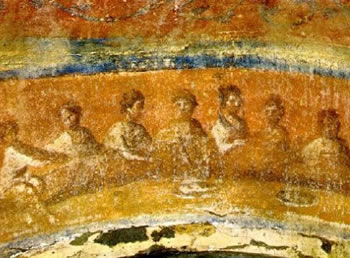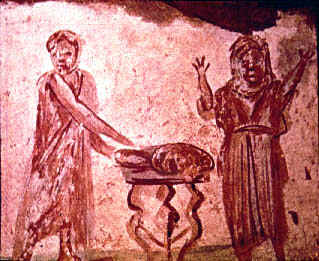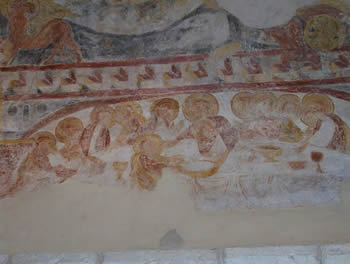Were the First Christians Cannibals?
"Eat My Flesh, Drink My Blood"
For Sunday August 26, 2012
Lectionary Readings (Revised Common Lectionary, Year B)
1 Kings 8:1, 6, 10–11, 22–30, 41–43 or Joshua 24:1–2a, 14–18
Psalm 84 or Psalm 34:15–22
Ephesians 6:10–20
John 6:56–59
One of the most scurrilous charges against early Christians was that they practiced ritual cannibalism. These charges were common enough that numerous second century writers felt constrained to refute them. The earliest explicit reference we have comes from Justin Martyr in Palestine around the year 150 AD. A few decades later in north Africa, Tertullian employed mock exaggeration to refute the claims: ‘Come! plunge the knife into the baby, nobody’s enemy, guilty of nothing, everybody’s child. . . catch the infant blood; steep your bread with it; eat and enjoy it’ (Apol. 8.2).
Charges of cannibalism might have been a case of mistaken identity; similar charges were made against Jews, and since the first Christians were all Jews they were often lumped together within them. Invoking a transgressive stereotype like cannibalism, regardless of whether it was true, was also a common way to marginalize any number of Greco-Roman groups of the day as dangerous threats to social norms — and early Christians certainly threatened social norms.
 |
Eucharist fresco. |
A simpler explanation for the charges of cannibalism was confusion surrounding the "flesh and blood" eucharistic rituals of the early believers. This week's gospel is a case in point.
John writes, "'Whoever eats my flesh and drinks my blood remains in me, and I in him. Just as the living Father sent me and I live because of the Father, so the one who feeds on me will live because of me. This is the bread that came down from heaven. Our forefathers ate manna and died, but he who feeds on this bread will live forever.' He said this while teaching in the synagogue in Capernaum."
John then describes how Jesus's controversial words scandalized the original audience. The Jews grumbled about comparing himself to God; wasn't he the son of Joseph, "whose father and mother we know? How can he say such things?" Even his own disciples dismissed Jesus's claim as a hard saying. Who can accept this, they protested? From that time on, says John, "many of his disciples turned back and no longer followed him" (6:66).
Ever since those first disciples deserted Jesus, Christians themselves have debated the meaning and method of the eucharist. If they couldn't explain just what they were doing, how could their detractors? So maybe it's no wonder that rumor, innuendo, and suspicion combined to result in charges of cannibalism. Just what were these socially marginal people doing in their secretive meetings?
What they were doing was taking Jesus at his word — and making the outrageous claim that the infinite God met them in an intimate way through a ritual sharing of bread and wine. But what about those rumors of eating the flesh and drinking the blood of Jesus?
 |
Eucharist fresco. |
In his book Font of Life (2012), Garry Wills observes how Augustine "ridiculed" the idea that the eucharistic bread and wine were the literal body and blood of Christ. "Augustine repeatedly says," writes Wills, "that Christ cannot be chewed, digested, and excreted." Augustine used a linguistic distinction to make a theological point.
In his commentary on John's gospel, Augustine argued that the words of Jesus refer to "the validity of the mystery, not to the visibility of the mystery, given to the one who eats inwardly, not outwardly, one who feeds his heart, not one who chews with his teeth." The bread and wine are "signs," said Augustine, and "the signs of divine things are, it is true, things visible, but … invisible things themselves are also honored in them." (De Cat. Rud. 26.50). A thousand years later the Council of Trent would thus describe a sacrament as a "visible sign of an invisible grace."
This divine-human encounter in the everyday elements of bread and wine is a mystery. And "mystery" is the word that Paul uses to describe the gospel itself in this week's epistle: "Pray for me, that whenever I open my mouth, words may be given me so that I will fearlessly make known the mystery of the gospel" (Ephesians 6:19). Who could ever feel adequate to proclaim the mystery of the gospel?
This word "mystery" occurs twenty times in the Greek New Testament, sixteen times in Paul, seven of which are in Ephesians alone. At some rudimentary level the story of Jesus in general, and its particular re-enactment in the eucharist, is an irreducible mystery. It's something that you can describe but never fully explain.
A mystery isn't an unknowable secret. In fact, Paul says the mystery has been fully revealed.
 |
Eucharist fresco. |
On the one hand, the gospel story is open to historical inquiry. The apostles insisted that their message was "true and reasonable," for the events they described were "not done in a corner" (Acts 26:25–26) but could be corroborated and verified, at least at some level and for a few years.
On the other hand, Paul admitted that his gospel was "to the Jews a stumbling block and to Greeks foolishness" (1 Corinthians 1:23). Luke wrote that the resurrected Jesus "was not seen by all the people, but by witnesses whom God had already chosen—by us who ate and drank with him after he rose from the dead" (Acts 10:41). Their witness thus amounted to what the Yale historian Jaroslav Pelikan once called "public evidence for a mystery."
The dead of summer might be a strange time for an Advent poem, but I love how John Betjeman (1906–1984) captures the scandalous mystery of the gospel in his poem Christmas. In the first five stanzas he describes the superficial busyness of Christmas decorations, parties and shopping. In the last three stanzas he pivots to the heart of the matter. Nothing you could ever claim remotely compares to the outrageous mystery of the gospel:
And is it true,
This most tremendous tale of all,
Seen in a stained-glass window's hue,
A Baby in an ox's stall?
The Maker of the stars and sea
Become a Child on earth for me?
And is it true? For if it is,
No loving fingers tying strings
Around those tissued fripperies,
The sweet and silly Christmas things,
Bath salts and inexpensive scent
And hideous tie so kindly meant,
No love that in a family dwells,
No carolling in frosty air,
Nor all the steeple-shaking bells
Can with this single Truth compare —
That God was man in Palestine
And lives today in Bread and Wine.
The charges of cannibalism fizzled out in the third century. But the mystery remains, that God was in Christ reconciling the world to himself.
Image credits: (1) Layanglicana.org; (2) Ookaboo.com; and (3) Nick Thompson.





